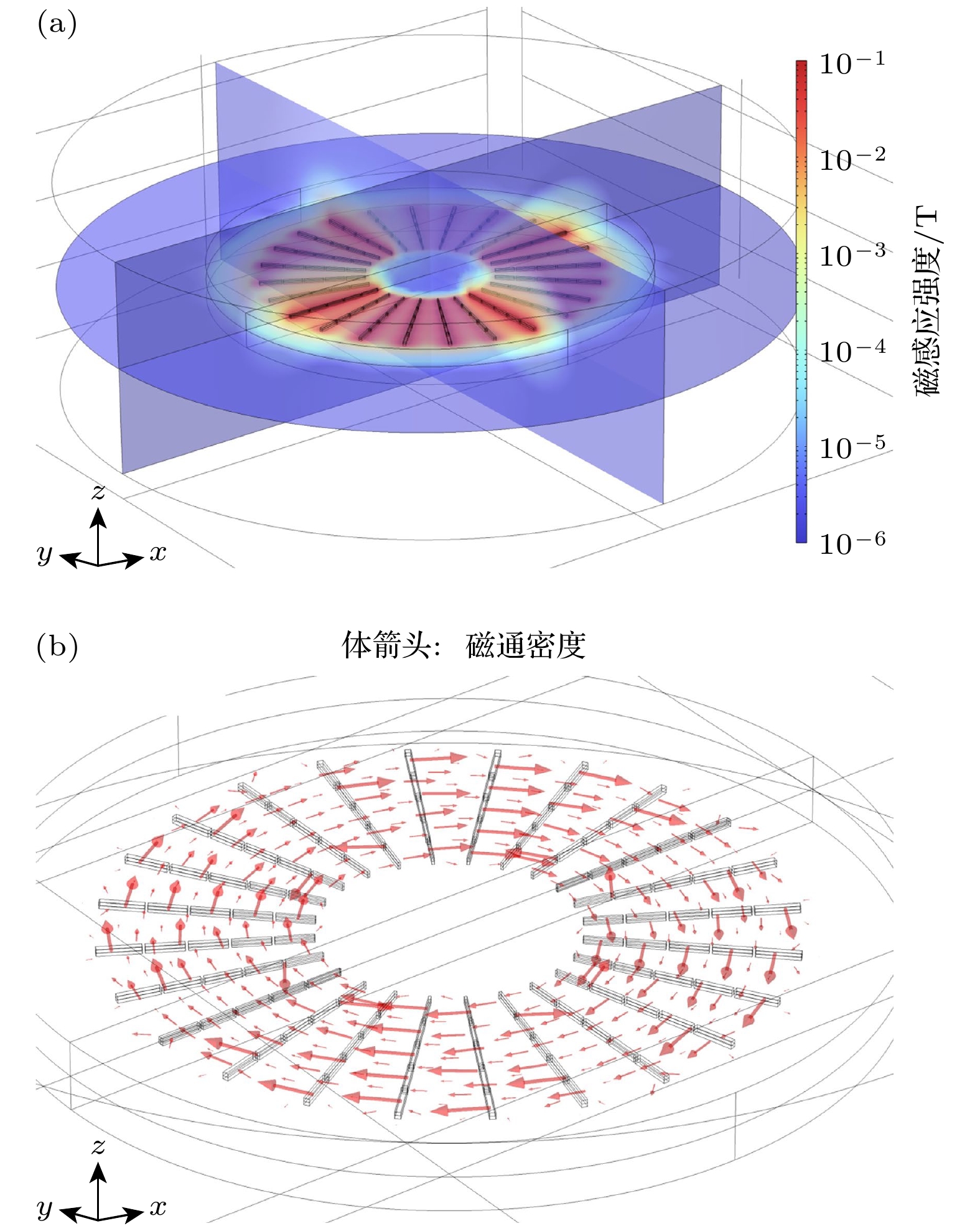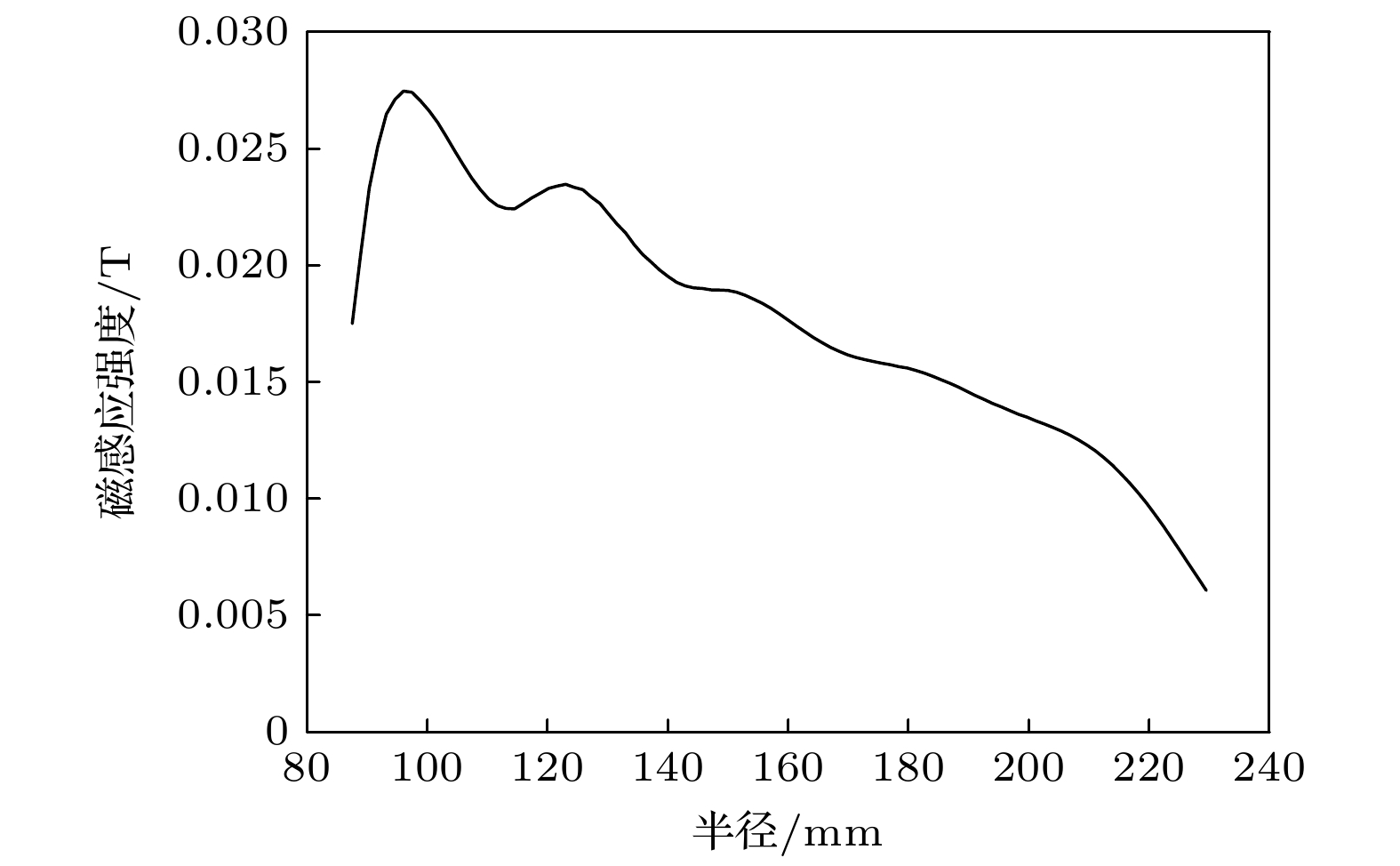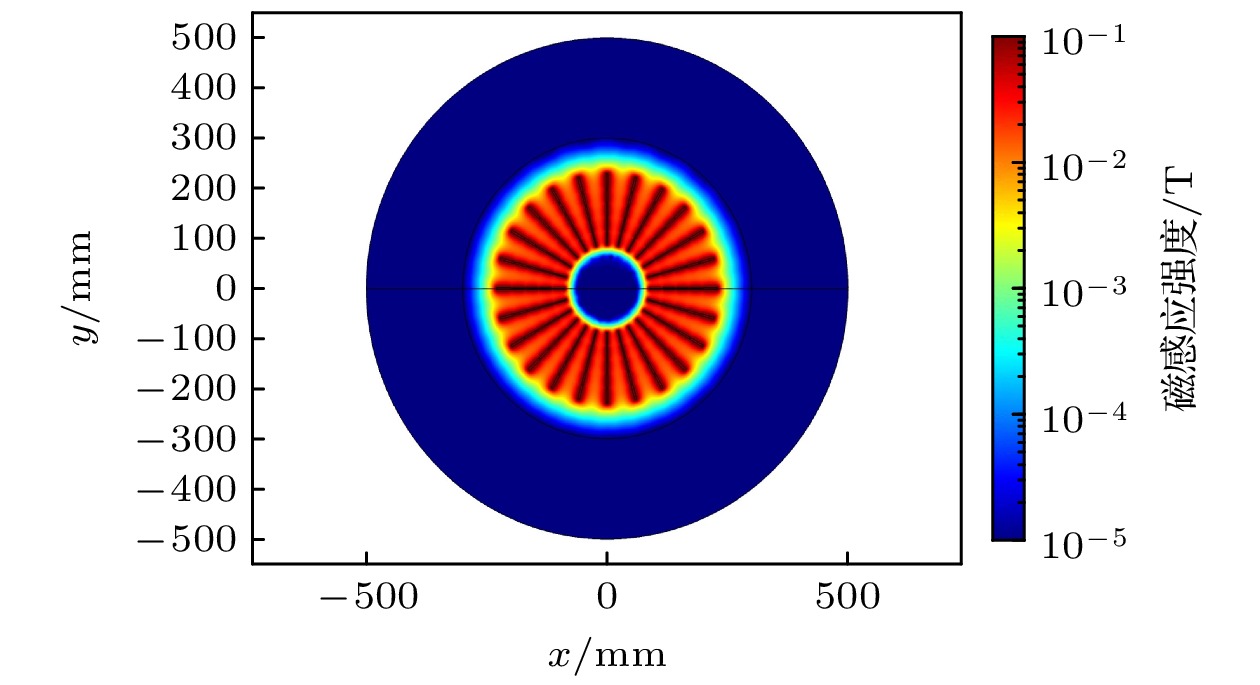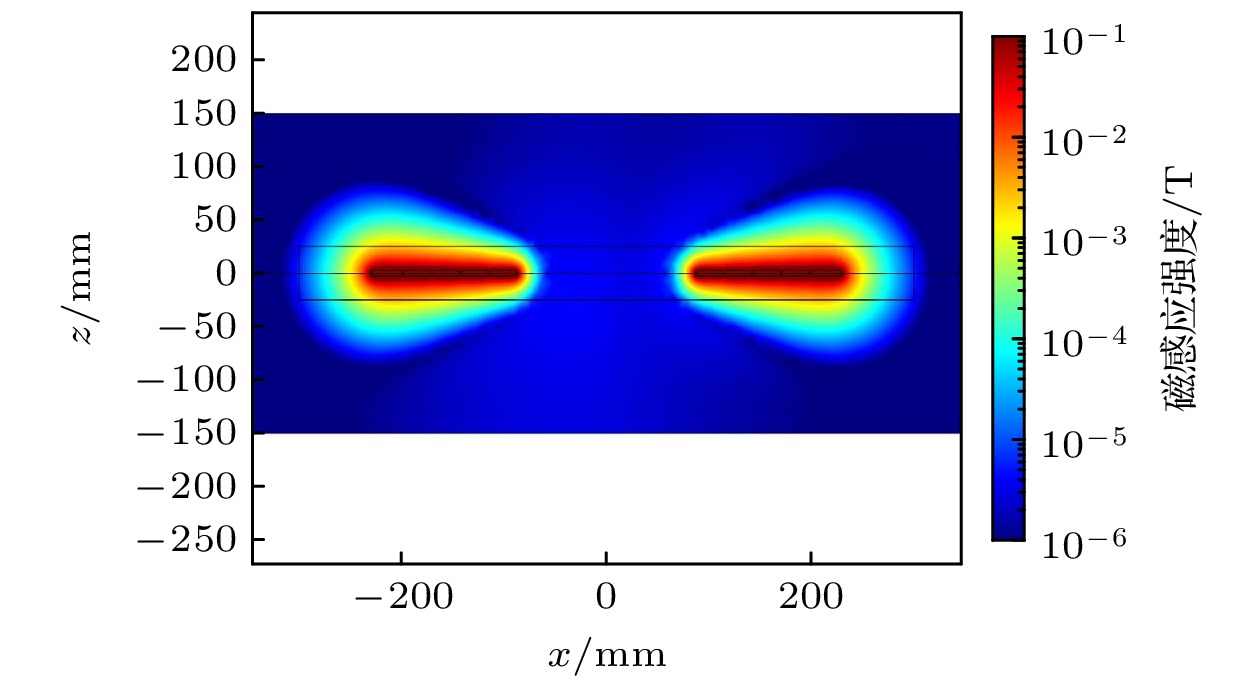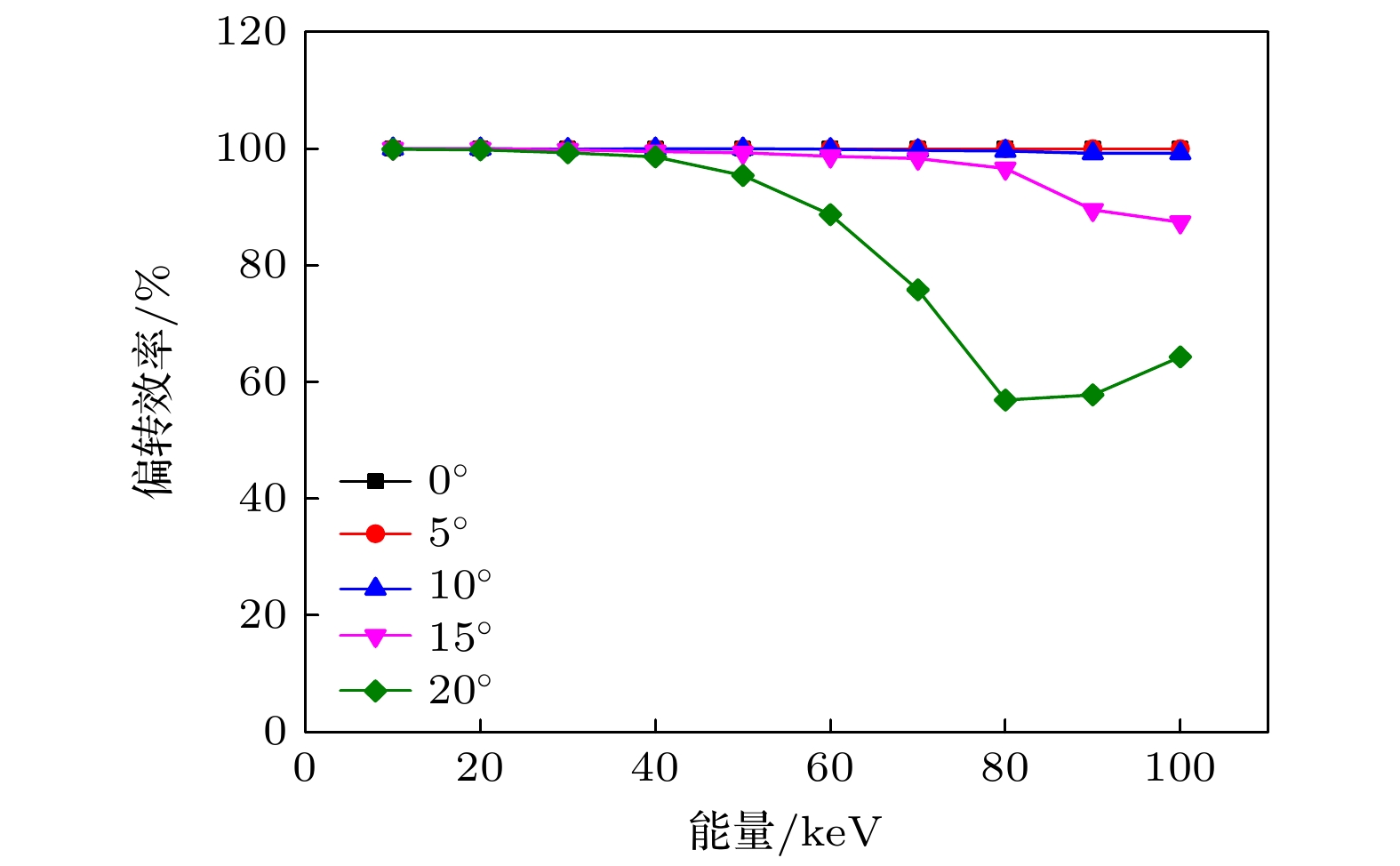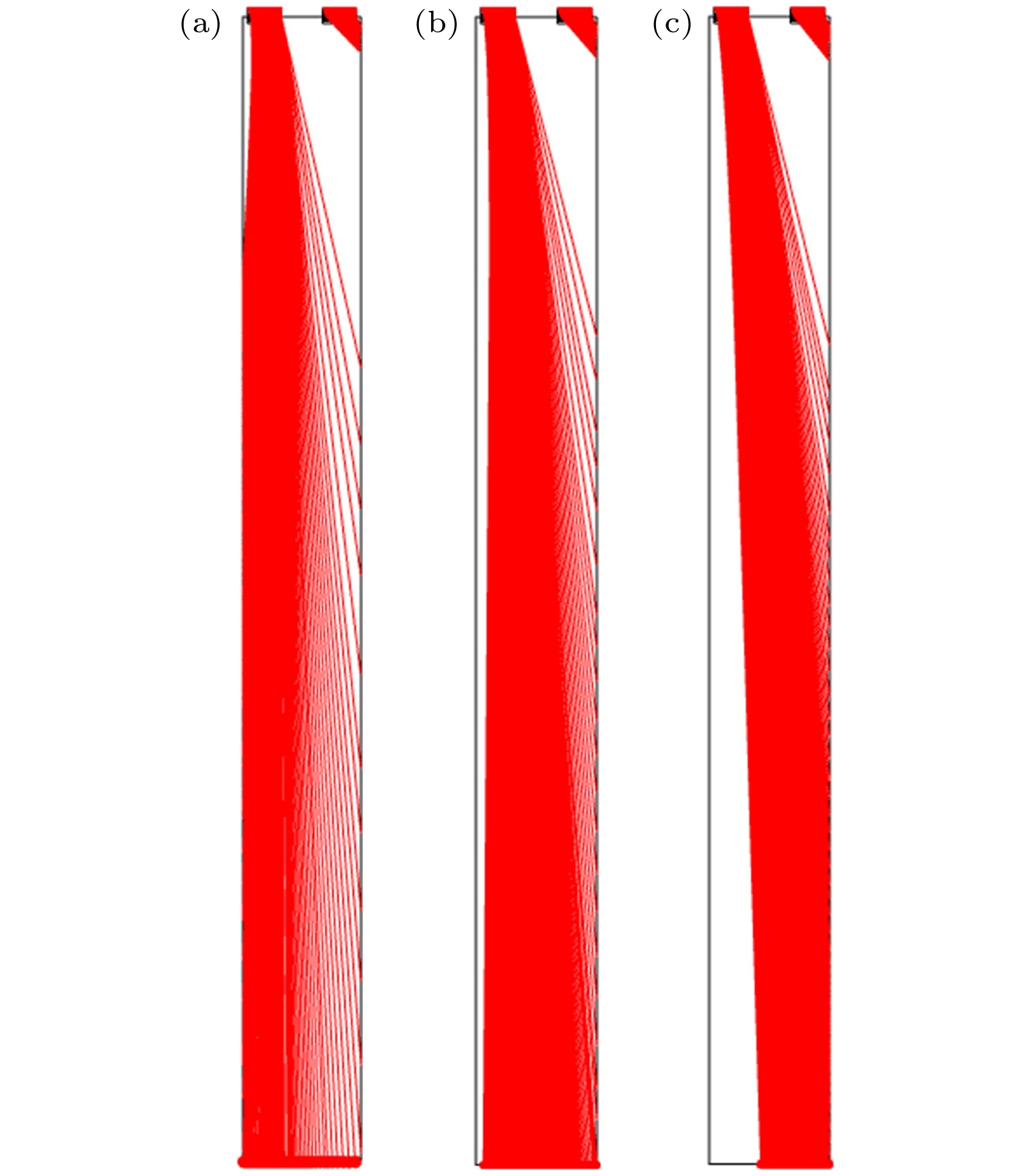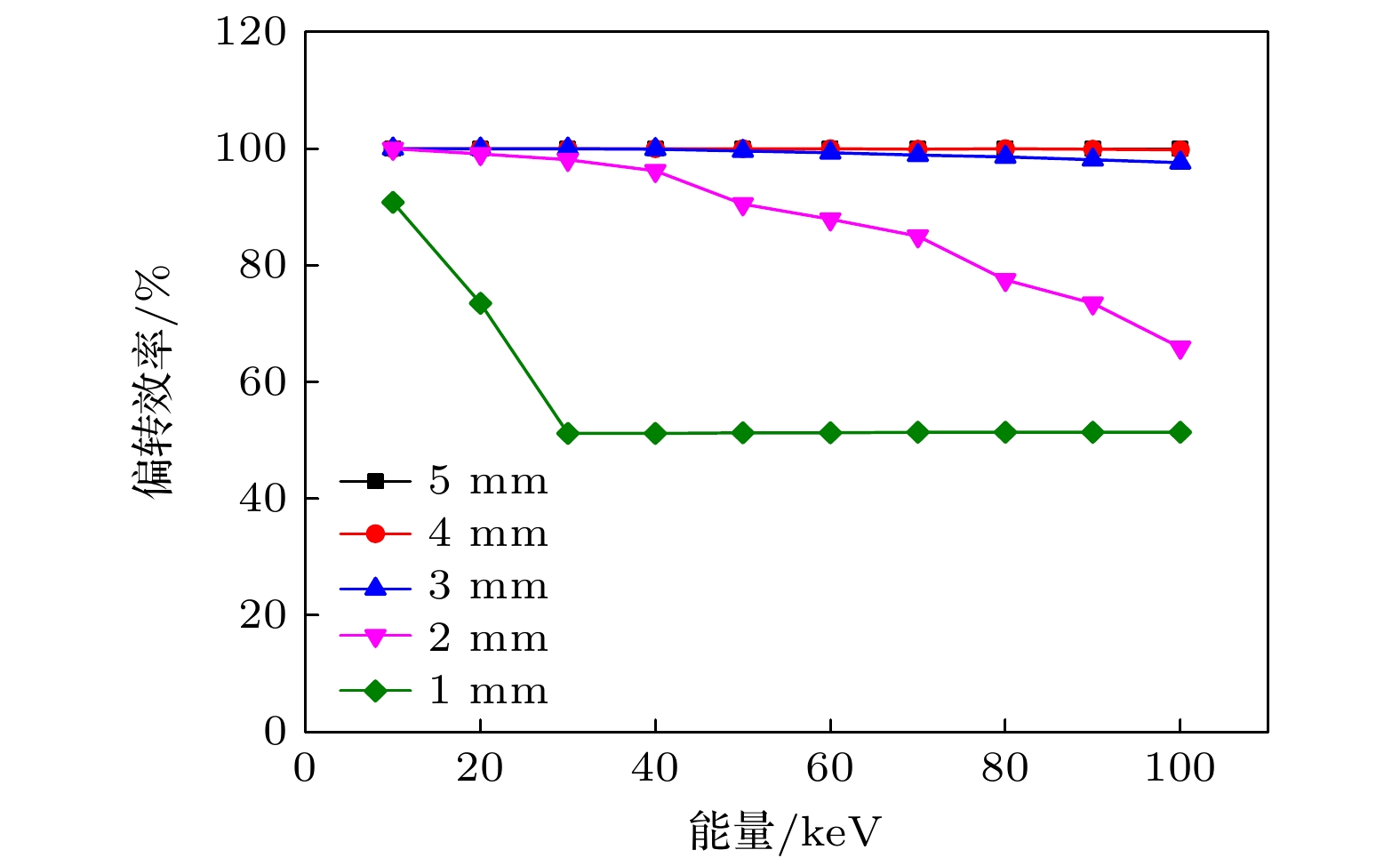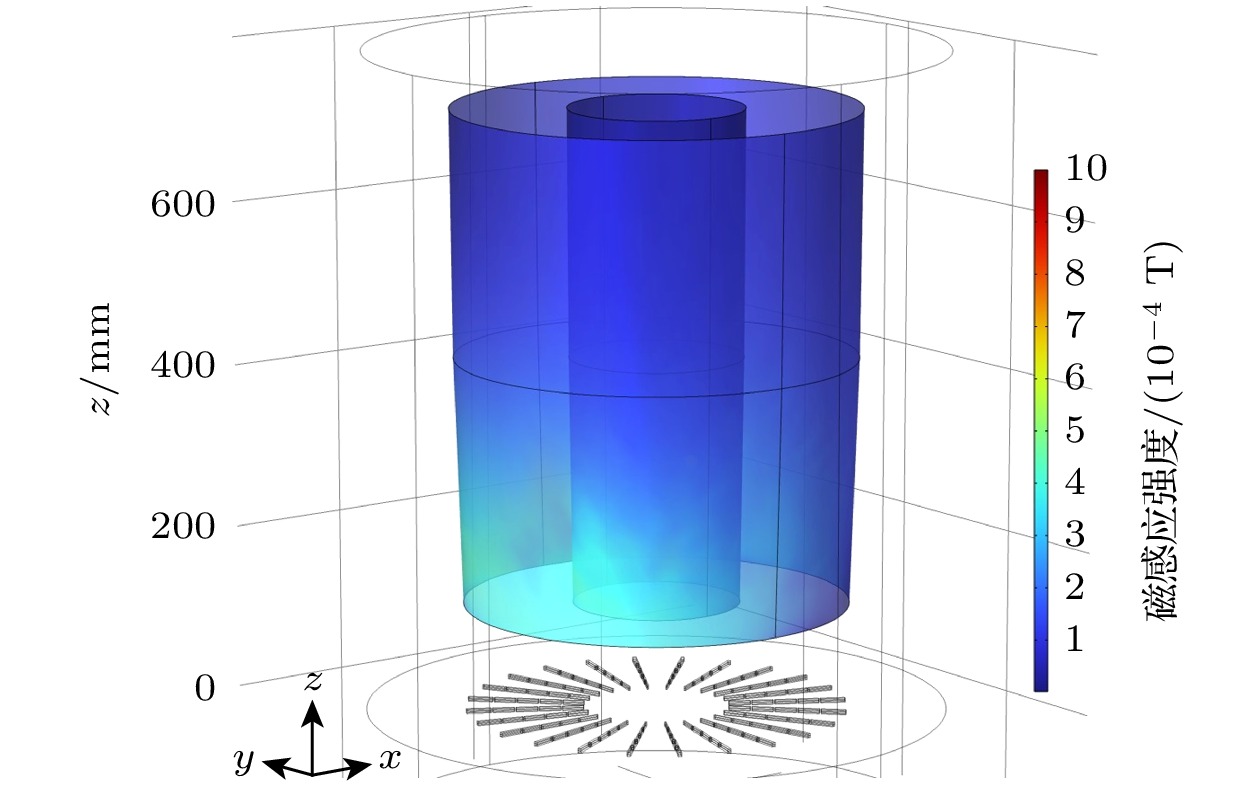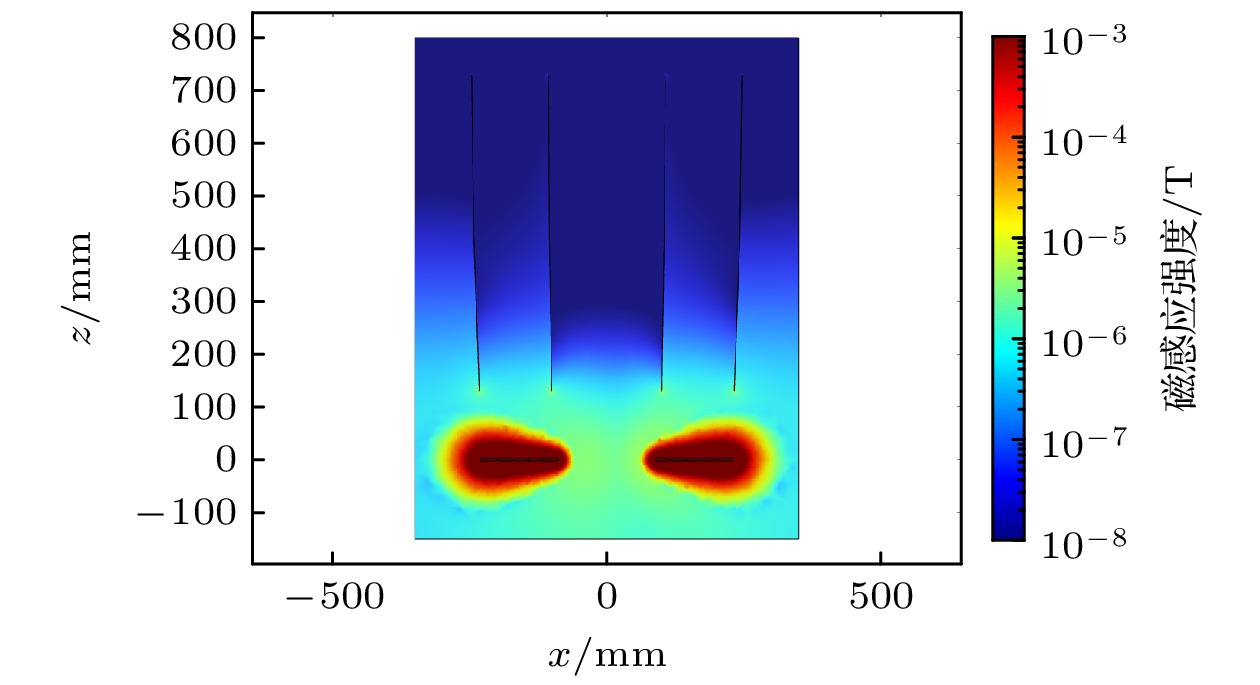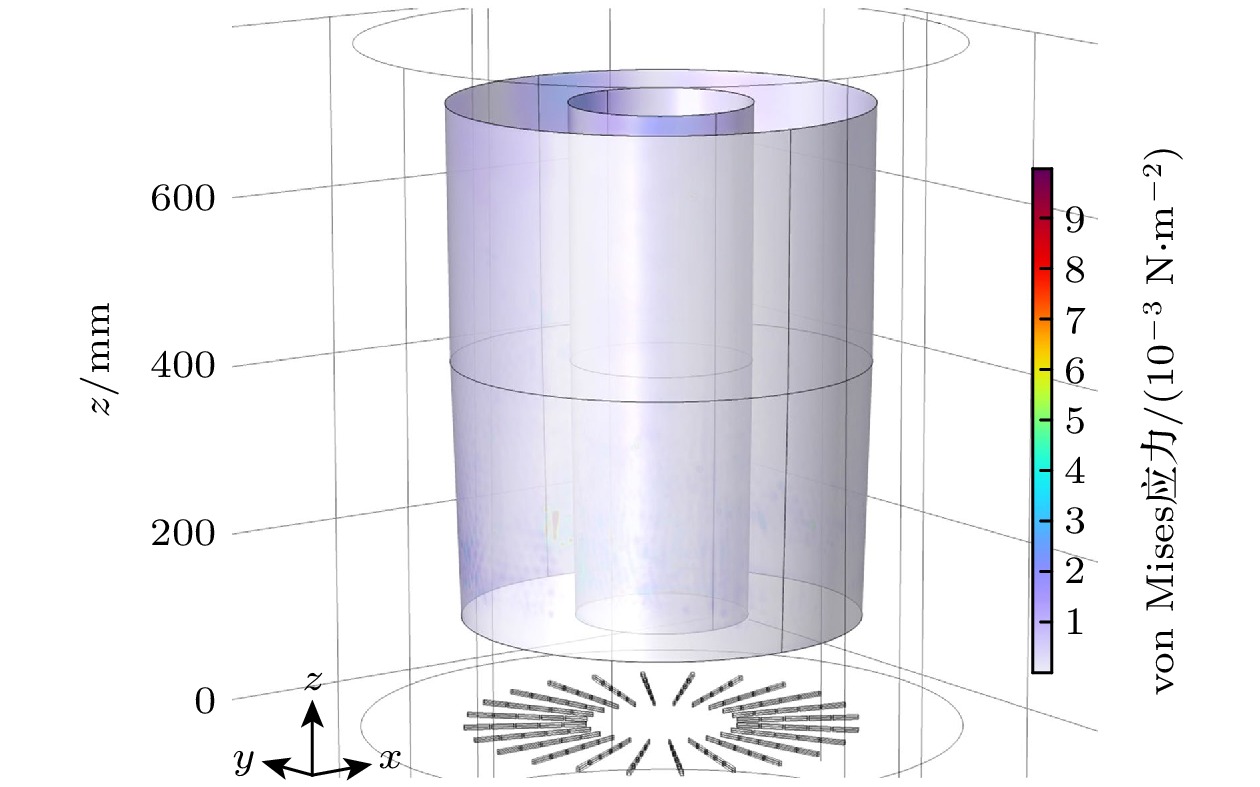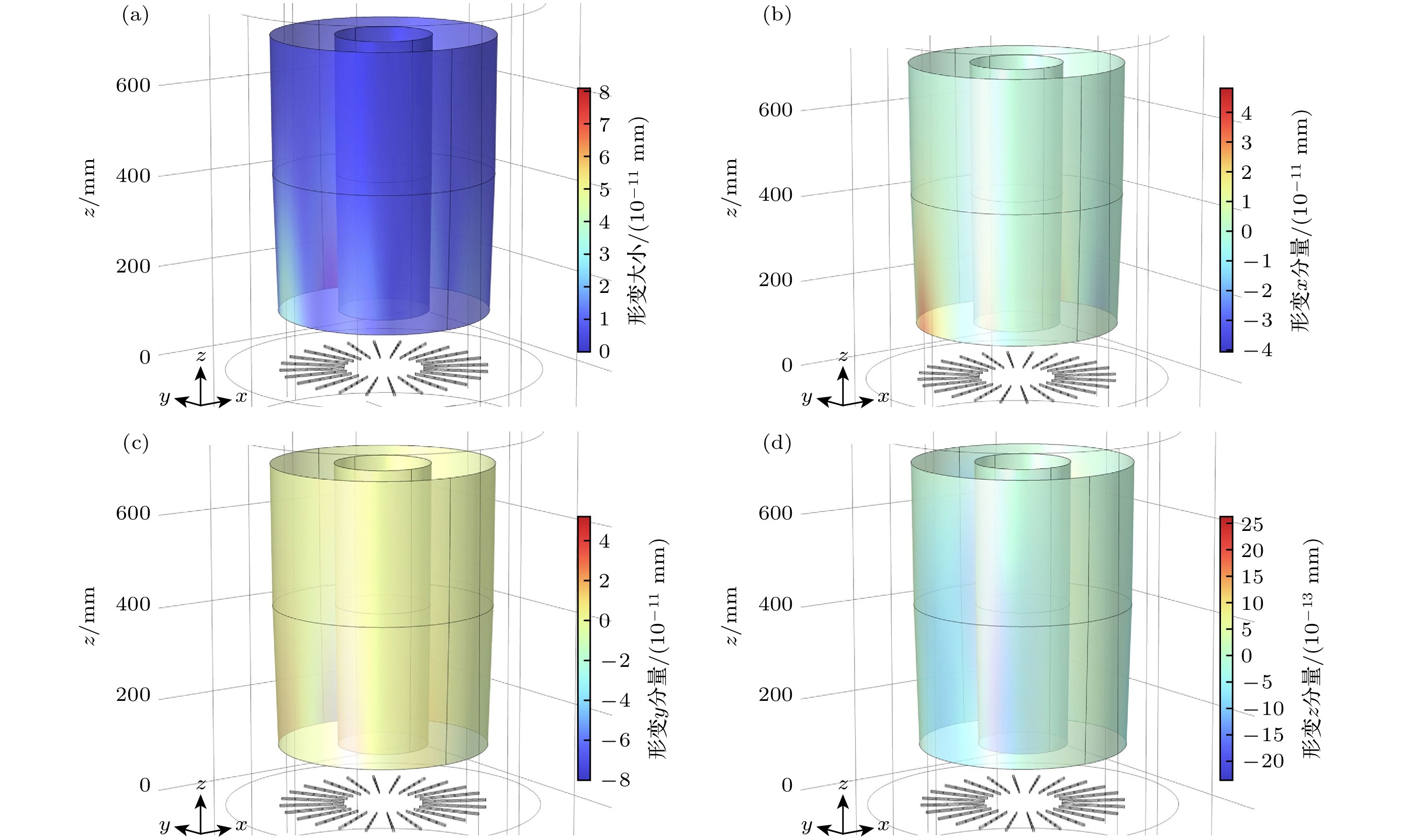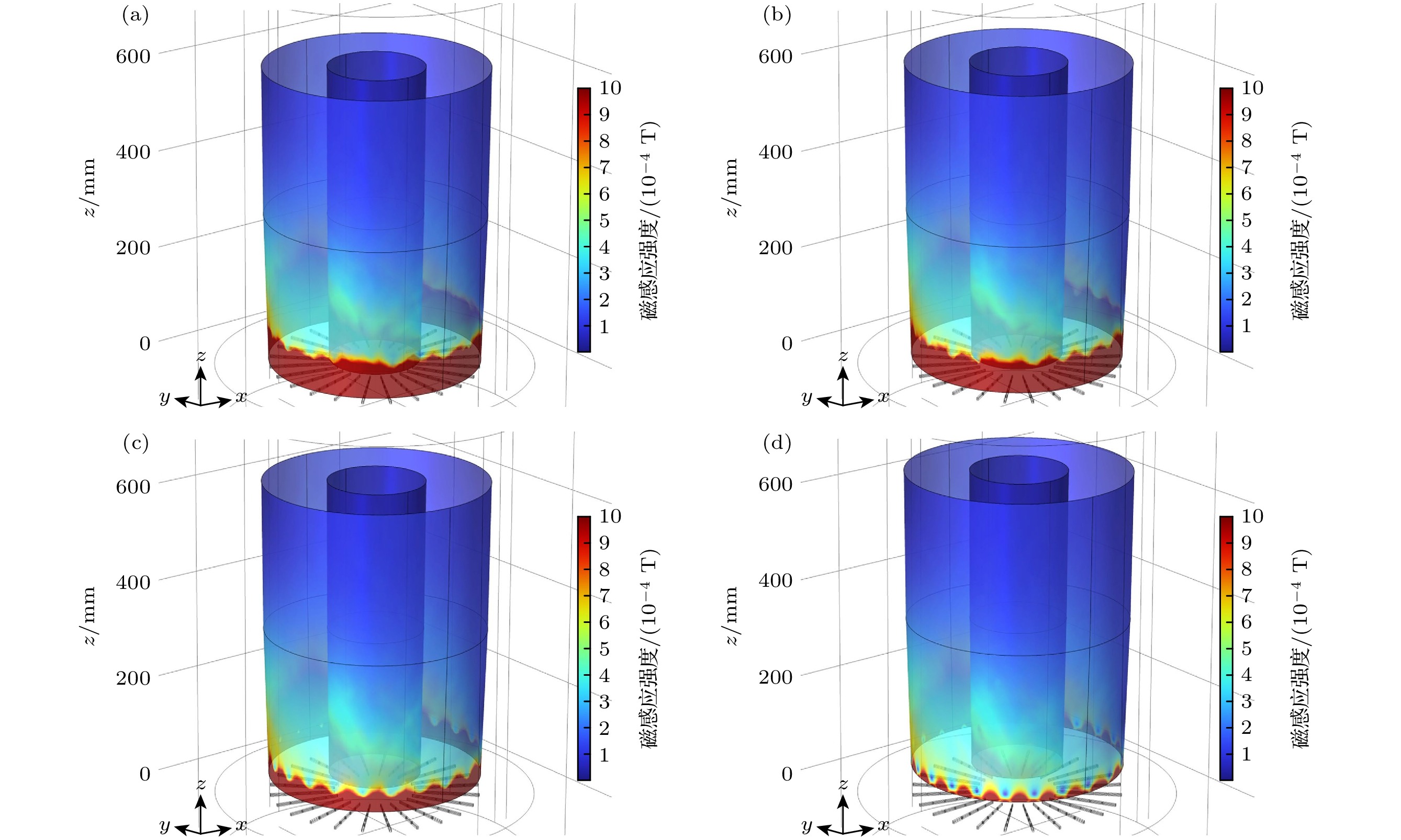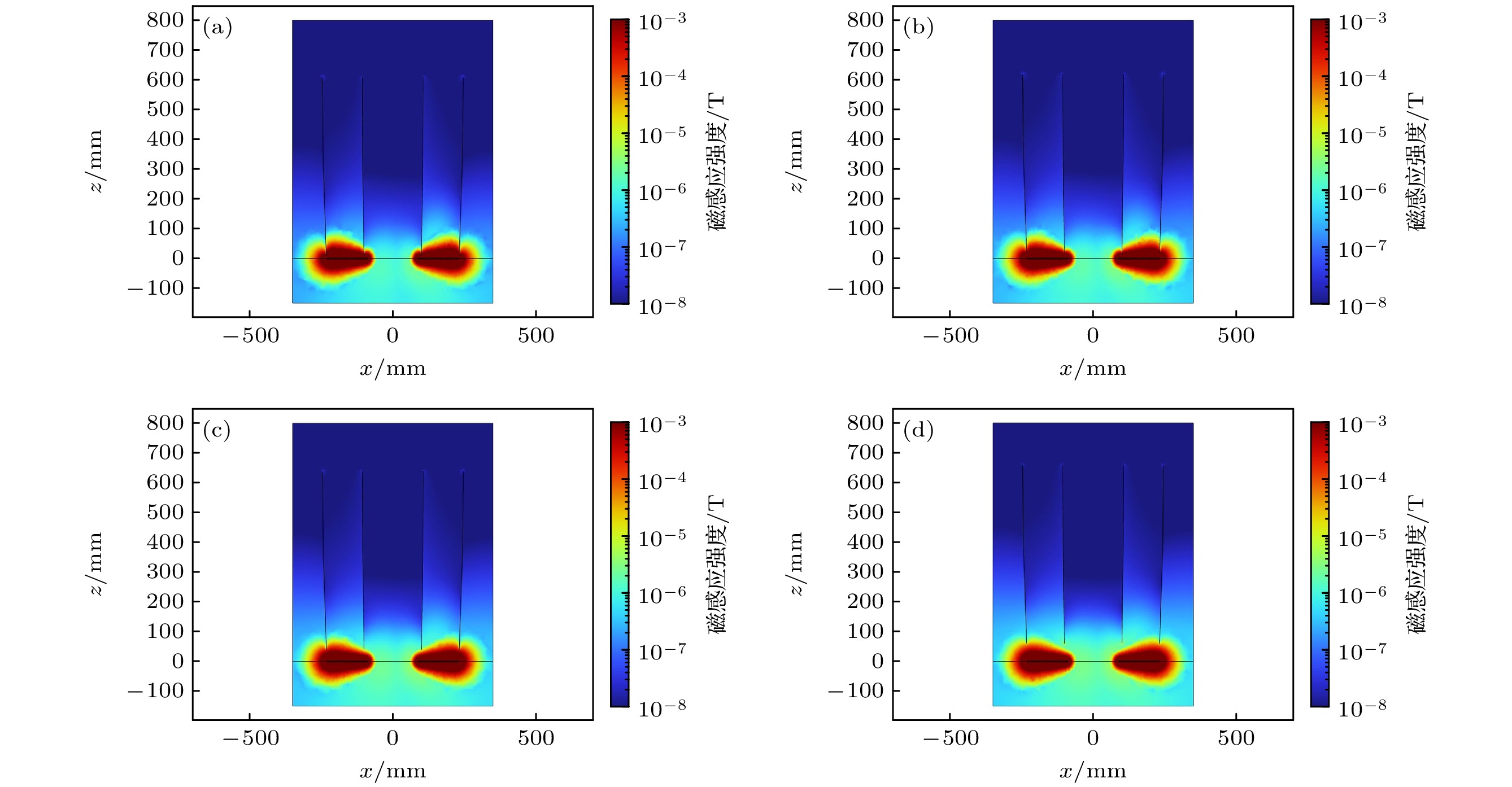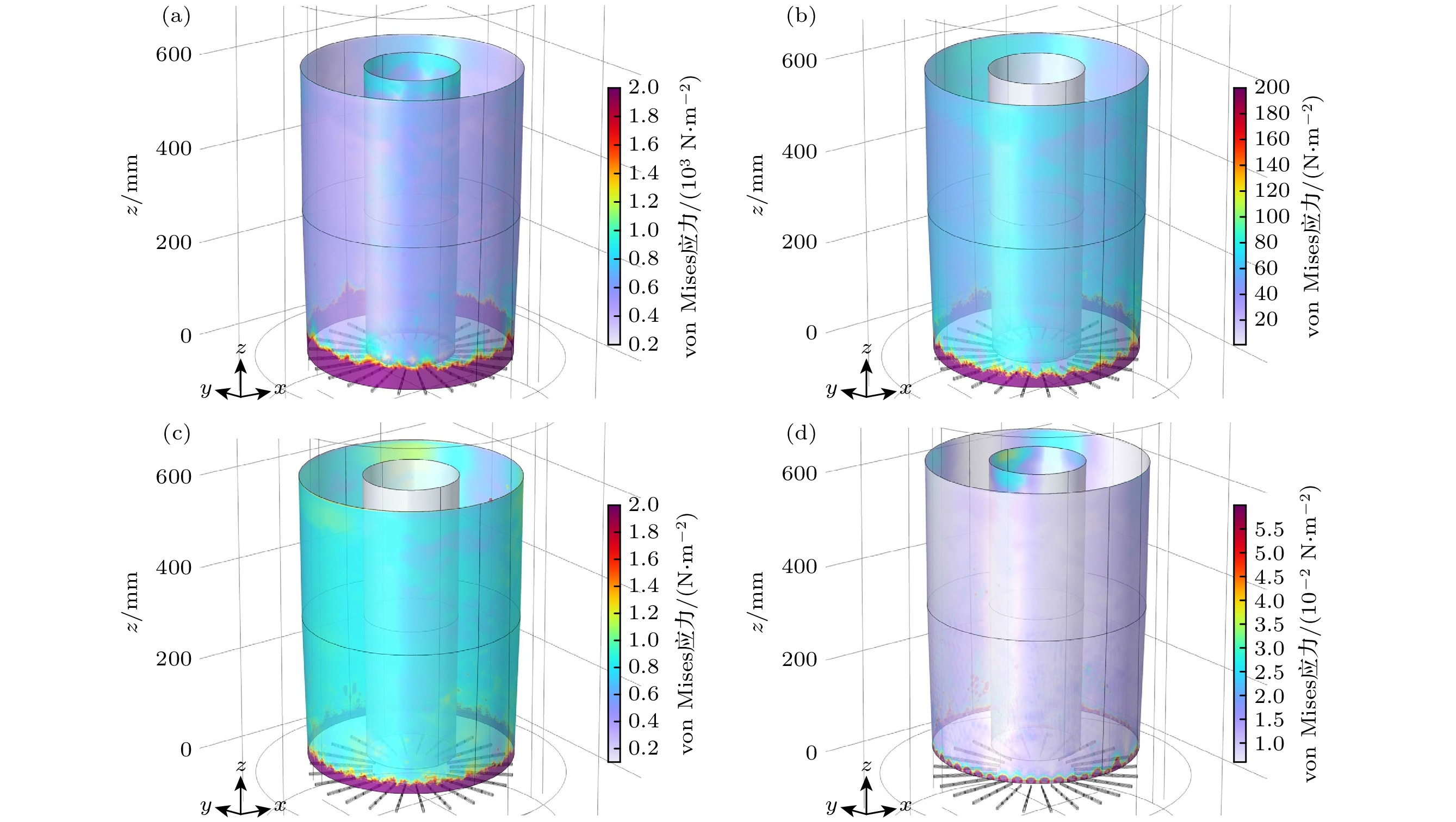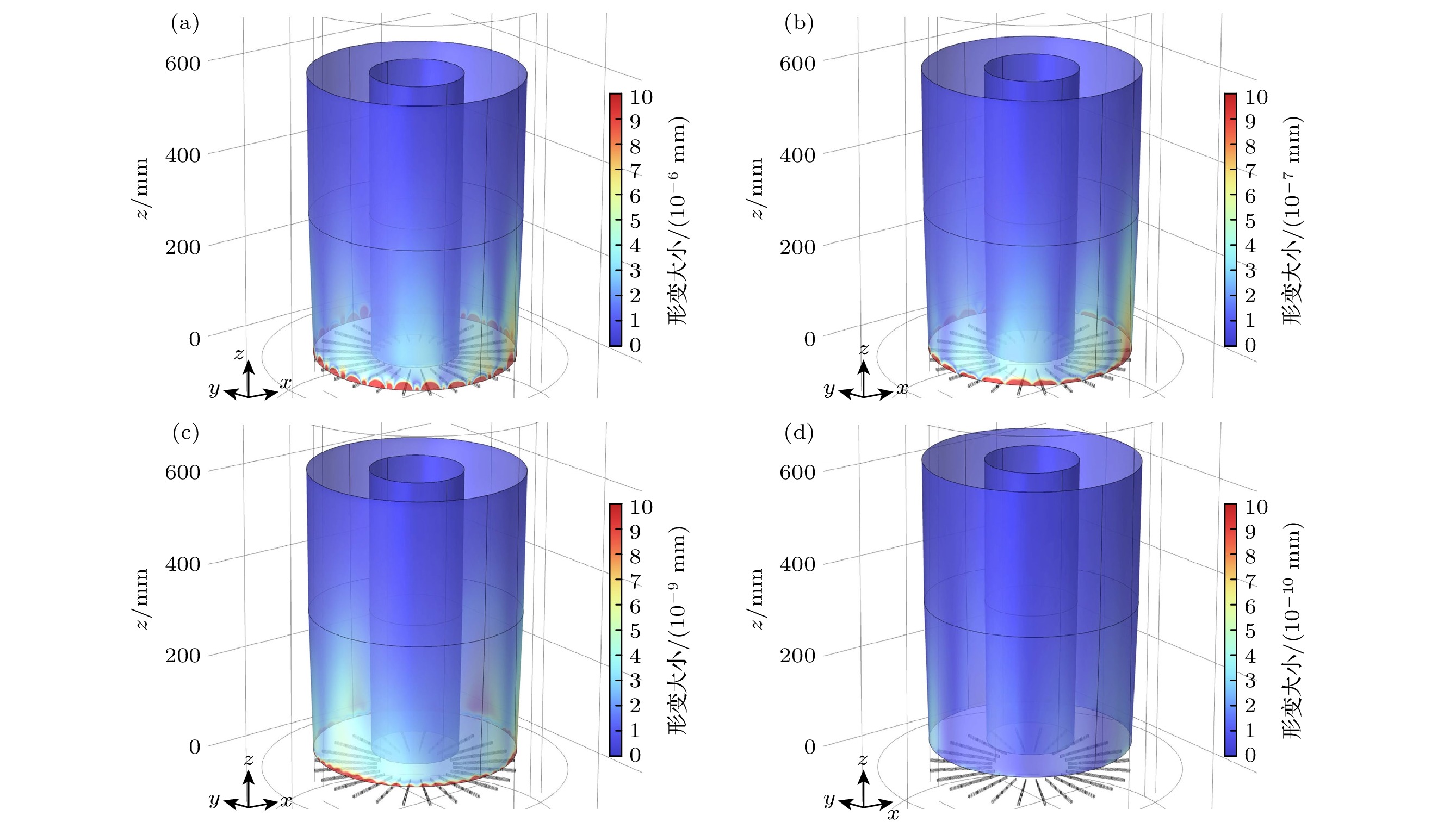-
X射线聚焦望远镜是进行空间X射线观测的核心设备, 为保证其观测结果的准确性, 需要对进入聚焦镜的低能电子进行有效偏转, 达到降低本底噪声的目的. 本文针对增强型X射线时变与偏振空间天文台(enhanced X-ray timing and polarimetry mission, eXTP)聚焦镜电子偏转器研制工作, 满足聚焦镜光学系统对于低能电子的偏转需求, 兼顾轻量化、电子偏转能力以及电磁兼容性能等问题, 采用有限元分析软件COMSOL Multiphysics建立了电子偏转器及聚焦镜镜片的全物理仿真模型, 分析了磁感应强度分布、电子偏转轨迹以及磁场对聚焦镜镜片的影响, 完成了电子偏转器电磁参数设计. 模拟结果表明, 电子偏转器周围空间中磁感应强度沿半径方向减小, 两根辐条正中间磁感应强度最大值可达0.027 T. 在磁感应强度平面及纵向分布中, 当半径大于280 mm或纵向距离大于60 mm时, 磁感应强度小于5×10–5 T (0.5 Gs), 满足电磁兼容性能设计要求. 当入射角≤10°时, 电子偏转效率随电子能量和入射角增大而减小, 50 keV能量以下电子偏转效率可达100%, 满足电子偏转设计要求. 聚焦镜镜片底端距离电子偏转器130 mm时, 聚焦镜镜片在磁场的作用下, 应力大小仅为10–3 N/m2量级, 形变大小仅为10–5 nm量级, 表明磁场不会对聚焦镜的光学性能产生影响. 这些结果为eXTP聚焦镜电子偏转器的研制工作提供了重要参考.X-ray focusing telescope is the core equipment for space X-ray observation. In order to ensure the accuracy of the observation results, it is necessary to deflect the low-energy electrons entering the focusing telescope to effectively reduce the background noise. In this work, the electron deflector for enhanced X-ray timing and polarimetry mission (eXTP) focusing telescope is developed to meet the deflection requirements of low-energy electrons in the focusing telescope optical system, with the lightweight, ability to deflect electrons , and electromagnetic compatibility considered. The finite element analysis software COMSOL Multiphysics is used to establish the full physical simulation model of the electron deflector and focusing telescope mirrors. The magnetic flux density distribution, electron deflection trajectories and the effect of magnetic field on focusing telescope mirrors are analyzed, and the electromagnetic parameters of the electron deflector are designed. The simulation results show that the closer to the magnet and the center of electron deflector, the greater the magnetic flux density, and the maximum magnetic flux density in the middle of the two spokes can reach 0.027 T. When the radius is larger than 280 mm, the longitudinal distance is larger than 60 mm, the magnetic flux density is less than 5×10–5 T (0.5 Gs), i.e. the geomagnetic intensity, which meets the design requirements of electromagnetic compatibility performance. When the incidence angle is ≤10°, the electron deflection efficiency decreases with the increase of electron energy and incidence angle, and the deflection efficiency of electrons below 50 keV energy can reach 100%, which meets the design requirements of electron deflection. In addition, as the focusing telescope mirrors are away from the electron deflector, the area of mirrors affected by the magnetic field becomes smaller and smaller. When the distance between the mirror bottom and electron deflector is 130 mm, the magnetic flux density at the mirror bottom only reaches 10–4 T. Similarly, as the focusing telescope mirrors are away from the electron deflector, the stress at the mirror bottom decreases from 103 N/m2 at 10 mm to 10–2 N/m2 at 60 mm, and the deformation at mirror bottom decreases from ~nm at 10 mm to 10–4 nm at 60 mm. When the distance between the mirror bottom and electron deflector is 130 mm, the stress is only 10–3 N/m2, and the deformation is only 10–5 nm, indicating that the magnetic field does not affect the optical properties of the focusing telescope. The above simulation analyses show that the design parameters of NdFeB magnet structure of the electron deflector fully meet the requirements of the eXTP focusing telescope optical system for the deflection of low-energy electrons. And the deflection efficiency of electrons with 25 keV energy, incidence angle within ±5°, and deflection distance of 5250 mm is 100%. These results provide an important reference for developing electron deflector of eXTP focusing telescope.
-
Keywords:
- focusing telescope /
- electron deflector /
- magnetic field /
- deflection efficiency /
- deformation
[1] 袁为民, 张臣, 陈勇, 孙胜利, 张永合, 崔伟, 凌志兴, 黄茂海, 赵冬华, 王文昕, 裘予雷, 刘柱, 潘海武, 蔡洪波, 邓劲松, 贾振卿, 金驰川, 孙惠, 胡海波, 刘飞飞, 张墨, 宋黎明, 卢方军, 贾淑梅, 李承奎, 赵海升, 葛明玉, 张娟, 崔苇苇, 王于仨, 王娟, 孙小进, 金戈, 黎龙辉, 陈凡胜, 蔡志鸣, 郭彤, 刘国华, 刘华秋, 冯骅, 张双南, 张冰, 戴子高, 吴雪峰, 苟利军 2018 中国科学: 物理学 力学 天文学 48 039502
 Google Scholar
Google Scholar
Yuan W M, Zhang C, Chen Y, Sun S L, Zhang Y H, Cui W, Lin Z X, Huang M H, Zhao D H, Wang W X, Qiu Y L, Liu Z, Pan H W, Cai H B, Deng J S, Jia Z Q, Jin C C, Sun H, Hu H B, Liu F F, Zhang M, Song L M, Lu F J, Jia S M, Li C K, Zhao H S, Ge M Y, Zhang J, Cui W W, Wang Y S, Wang J, Sun X J, Jin G, Li L H, Chen F S, Cai Z M, Guo T, Liu G H, Liu H Q, Feng H, Zhang S N, Zhang B, Dai Z G, Wu X F, Gou L J 2018 Sci. China: Phys. Mech. 48 039502
 Google Scholar
Google Scholar
[2] Jeong S, Panasyuk M I, Reglero V 2018 Space Sci. Rev. 214 25
 Google Scholar
Google Scholar
[3] Zhang S N, Santangelo A, Feroci M 2019 Sci. China Phys. Mech. 62 25
[4] Zand J J M, Bozzo E, Qu J L 2019 Sci. China Phys. Mech. 62 029506
 Google Scholar
Google Scholar
[5] Aslanyan V, Keresztes K, Feldman C, Pearson J F, Willingale R, Martindale A, Sembay S, Osborne J P, Sachdev S S, Bicknell C L, Houghton P R, Crawford T, Chornay D 2019 Rev. Scientif. Inst. 90 124502
 Google Scholar
Google Scholar
[6] Zhang S N, Santangelo A, Feroci M, et al. 2018 Sci. China: Phys. Mech. 62 029502
[7] Yuan W M, Zhang C, Feng H, et al. 2015 Swift: 10 Years of Discovery
[8] Yuan W M, Chen Z, Ling Z, et al. 2018 Proc. SPIE: Space Telescopes and Instrumentation 2018: Ultraviolet to Gamma Ray 2018 1069925
[9] Chen Y, Cui W W, Han D W, et al. 2020 Proc. SPIE: Space Telescopes and Instrumentation 2020: Ultraviolet to Gamma Ray 2020 11444B
[10] Gehrels N, Chincarini G, Giommi P, et al. 2004 Astrophys. J. 611 1309
[11] Willingale R 2000 An electron diverter for the Swift Telescope XRA study note XRT-LUX-RE-011/1 (University of Leicester
[12] Friedrich P, Bräuninger H, Budau B, et al. 2012 Proc. SPIE 8443 84431S
 Google Scholar
Google Scholar
[13] Spiga D, Fioretti V, Bulgarelli A, et al. 2008 Proc. SPIE: Space Telescopes and Instrumentation 2008: Ultraviolet to Gamma Ray 7011 70112Y
[14] Wang L, Qin L, Cheng J, et al. 2020 IEEE Trans. Appl. Supercond. 30 1
[15] Lotti S, Mineo T, Jacquey C, et al. 2018 Exp. Astron. 45 411
 Google Scholar
Google Scholar
[16] Fioretti V, Bulgarelli A, Molendi S, et al. 2018 Astrophys. J. 867 9
 Google Scholar
Google Scholar
[17] Qi L Q, Li G, Xu Y P, et al. 2020 Nucl. Instrum. Meth. A 963 163702
 Google Scholar
Google Scholar
[18] Qi L Q, Li G, Xu Y P, Chen Y, He H L, Wang Y S, Yang Y J, Zhang J, Lu F J 2021 Exp. Astron. 51 475
 Google Scholar
Google Scholar
[19] Aguilar M, Alcaraz J, Allaby J, et al. 2002 Phys. Rep. 366 331
 Google Scholar
Google Scholar
[20] Aguilar M, Cavasonza L A, Ambrosi G, et al. 2021 Phys. Rep. 894 1
 Google Scholar
Google Scholar
-
图 16 聚焦镜镜片底端距离电子偏转器 (a) 10 mm, (b) 20 mm, (c) 40 mm, (d) 60 mm时电子偏转器及聚焦镜镜片周围空间磁感应强度分布
Fig. 16. Distribution of magnetic flux density around the electron deflector and focusing telescope mirrors when the distance between the mirror bottom and electron deflector is (a) 10 mm, (b) 20 mm, (c) 40 mm, and (d) 60 mm.
表 1 电子偏转器各材料参数
Table 1. Material parameters of the electron deflector.
名称 材料/型号 数量 密度/(kg·m–3) 杨氏模量/(N·mm–2) 泊松比 质量/kg 电子偏转器法兰 AA7075 1 2800 70000 0.33 0.339 磁铁 NdFeB 120 7400 140000 — 0.224 螺丝 TC4 — 7900 210000 0.3 0.003 粘合胶 EC2216 — — — — — 表 2 电子偏转器钕铁硼(NdFeB)磁铁结构设计参数
Table 2. Structure design parameters of the electron deflector NdFeB magnet.
序号 长度/mm 宽度/mm 高度/mm 剩磁/T #1 26 1.8 5 1.4 #2 26 2.5 5 1.4 #3 26 3 5 1.4 #4 26 3.5 5 1.4 #5 30 4 5 1.4 -
[1] 袁为民, 张臣, 陈勇, 孙胜利, 张永合, 崔伟, 凌志兴, 黄茂海, 赵冬华, 王文昕, 裘予雷, 刘柱, 潘海武, 蔡洪波, 邓劲松, 贾振卿, 金驰川, 孙惠, 胡海波, 刘飞飞, 张墨, 宋黎明, 卢方军, 贾淑梅, 李承奎, 赵海升, 葛明玉, 张娟, 崔苇苇, 王于仨, 王娟, 孙小进, 金戈, 黎龙辉, 陈凡胜, 蔡志鸣, 郭彤, 刘国华, 刘华秋, 冯骅, 张双南, 张冰, 戴子高, 吴雪峰, 苟利军 2018 中国科学: 物理学 力学 天文学 48 039502
 Google Scholar
Google Scholar
Yuan W M, Zhang C, Chen Y, Sun S L, Zhang Y H, Cui W, Lin Z X, Huang M H, Zhao D H, Wang W X, Qiu Y L, Liu Z, Pan H W, Cai H B, Deng J S, Jia Z Q, Jin C C, Sun H, Hu H B, Liu F F, Zhang M, Song L M, Lu F J, Jia S M, Li C K, Zhao H S, Ge M Y, Zhang J, Cui W W, Wang Y S, Wang J, Sun X J, Jin G, Li L H, Chen F S, Cai Z M, Guo T, Liu G H, Liu H Q, Feng H, Zhang S N, Zhang B, Dai Z G, Wu X F, Gou L J 2018 Sci. China: Phys. Mech. 48 039502
 Google Scholar
Google Scholar
[2] Jeong S, Panasyuk M I, Reglero V 2018 Space Sci. Rev. 214 25
 Google Scholar
Google Scholar
[3] Zhang S N, Santangelo A, Feroci M 2019 Sci. China Phys. Mech. 62 25
[4] Zand J J M, Bozzo E, Qu J L 2019 Sci. China Phys. Mech. 62 029506
 Google Scholar
Google Scholar
[5] Aslanyan V, Keresztes K, Feldman C, Pearson J F, Willingale R, Martindale A, Sembay S, Osborne J P, Sachdev S S, Bicknell C L, Houghton P R, Crawford T, Chornay D 2019 Rev. Scientif. Inst. 90 124502
 Google Scholar
Google Scholar
[6] Zhang S N, Santangelo A, Feroci M, et al. 2018 Sci. China: Phys. Mech. 62 029502
[7] Yuan W M, Zhang C, Feng H, et al. 2015 Swift: 10 Years of Discovery
[8] Yuan W M, Chen Z, Ling Z, et al. 2018 Proc. SPIE: Space Telescopes and Instrumentation 2018: Ultraviolet to Gamma Ray 2018 1069925
[9] Chen Y, Cui W W, Han D W, et al. 2020 Proc. SPIE: Space Telescopes and Instrumentation 2020: Ultraviolet to Gamma Ray 2020 11444B
[10] Gehrels N, Chincarini G, Giommi P, et al. 2004 Astrophys. J. 611 1309
[11] Willingale R 2000 An electron diverter for the Swift Telescope XRA study note XRT-LUX-RE-011/1 (University of Leicester
[12] Friedrich P, Bräuninger H, Budau B, et al. 2012 Proc. SPIE 8443 84431S
 Google Scholar
Google Scholar
[13] Spiga D, Fioretti V, Bulgarelli A, et al. 2008 Proc. SPIE: Space Telescopes and Instrumentation 2008: Ultraviolet to Gamma Ray 7011 70112Y
[14] Wang L, Qin L, Cheng J, et al. 2020 IEEE Trans. Appl. Supercond. 30 1
[15] Lotti S, Mineo T, Jacquey C, et al. 2018 Exp. Astron. 45 411
 Google Scholar
Google Scholar
[16] Fioretti V, Bulgarelli A, Molendi S, et al. 2018 Astrophys. J. 867 9
 Google Scholar
Google Scholar
[17] Qi L Q, Li G, Xu Y P, et al. 2020 Nucl. Instrum. Meth. A 963 163702
 Google Scholar
Google Scholar
[18] Qi L Q, Li G, Xu Y P, Chen Y, He H L, Wang Y S, Yang Y J, Zhang J, Lu F J 2021 Exp. Astron. 51 475
 Google Scholar
Google Scholar
[19] Aguilar M, Alcaraz J, Allaby J, et al. 2002 Phys. Rep. 366 331
 Google Scholar
Google Scholar
[20] Aguilar M, Cavasonza L A, Ambrosi G, et al. 2021 Phys. Rep. 894 1
 Google Scholar
Google Scholar
计量
- 文章访问数: 2745
- PDF下载量: 85
- 被引次数: 0














 下载:
下载:

